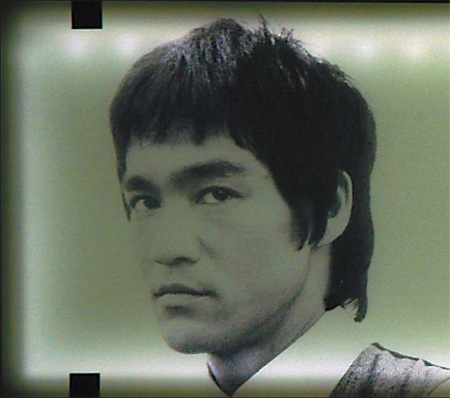Lin's design for MOCA helps visitors take a journey through the history of the Chinese in the US, and is itself an homage to a dying tradition in China - that of the courtyard house. Traditional homes in China are built around a courtyard, where the family gather. Surrounding the courtyard are areas of the house where family members reside, including the extended family.
 |
|
Bruce Lee
|
The center of the museum is an open area of exposed brick where a staircase leads to the bottom floor of the museum. The exposed brick and unfinished appearance in the central "courtyard" area is part of Lin's vision, to show the scars and rough beauty of the original space, Mong says.
Surrounding the central area is the museum itself, filled with the pictures and stories of Chinese immigrants in America. Much of the museum is wired so that displays of antiquated photographs and text are positioned next to electronic displays of individuals telling the tales of their lives in the US.
The journey starts in a room dedicated to the traders who traveled to the US for business and quickly moves to the early Chinese who came to America for work. Each room has back-lit plaques of photographs and text of various individuals and their stories. For example, one plaque shows Joseph Pierce, who was a member of the 14th Connecticut Infantry in the Civil War and fought in the battles of Antietam and Gettysburg.
Another plaque shows Tom Gunn, born in 1890, the first Chinese American to earn a US pilot's license.
The rooms correspond to the various decades and lead up to the present day, where prominent Chinese Americans such as Steven Chu, the US secretary of energy, and Elaine Chao, the former US secretary of labor, are featured.
The displays do not pull any punches. The more tragic aspects of the Chinese experiences in the US are highlighted as well. One display is dedicated to the hundreds of Chinese travelers who were detained on Angel Island in San Francisco, where they had to await authorization to travel into the US, sometimes for indefinite periods. The display includes a copy of a section of the wooden barracks where the detained people lived, carved with passages of sorrowful poetry lamenting the loss of freedom.
The history related in the museum discusses the Exclusion Act of 1882 that prevented Chinese from becoming American citizens and the hardships that life under the Act produced.
"The history of immigration in the US is not always positive," Mong says. "As Chinese Americans suffered injustices, we'll show that."
The plan for MOCA is continued growth in the future, as more people become aware of the museum and more people and organizations become involved.
Mong hopes that people from the Chinese mainland will learn about the museum and include it on their agendas when they visit the US and is "issuing a challenge" to Chinese companies operating in the US to step up and help contribute to MOCA's growth.
Until then, MOCA hopes to present each new chapter of the narratives of Chinese Americans, collecting the tales of how the previous generations overcame various hardships and contributed not only to the vibrant community called Chinatown, but to America as a whole.
(China Daily September 21, 2009)